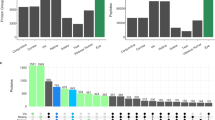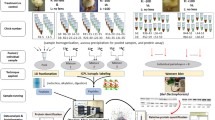Abstract
Lack of tyrosine O Sulfation compromises both rod and cone electroretinographic responses emphasizing the importance of this post-translational modification for vision. To identify tyrosine sulfated proteins in retina, cow retinal lysates were subjected to immunoaffinity purification using an anti-sulfotyrosine antibody. The tyrosine sulfated proteins were eluted from the column using a sulfotyrosine pentapeptide and identified using mass spectrometry. Similarly, tyrosine sulfated proteins secreted by the 661W cell line were identified. Proteins identified were vitronectin, fibronectin, fibulin 2, nidogen, collagen V alpha 2, complement component 3 and C4 and fibrinogen beta. All proteins were subjected to analysis by ‘Sulfinator’ to determine potential sulfated tyrosines.
Access provided by Autonomous University of Puebla. Download conference paper PDF
Similar content being viewed by others
Keywords
1 Introduction
Tyrosine sulfation is a post-translational modification of proteins that is utilized in all ocular tissues (Kanan et al. 2009, 2012) and plays a very important role in vision (Sherry et al. 2010, 2012) . Eliminating tyrosine sulfation reduces scotopic electroretinographic responses to 25 % of normal and photopic responses to 15 % of normal (Sherry et al. 2010). Besides these functional deficits, ultrastructural examination reveals rod outer segments abnormalities (Sherry et al. 2010). To identify the tyrosine sulfated proteins that may be responsible for these effects, we immunoaffinity purified tyrosine sulfated proteins from neural retina using the anti-sulfotyrosine antibody PSG2 (Hoffhines et al. 2006) . Column elution using a sulfated pentapeptide was followed by mass spectrometry. Since all sulfated proteins are secreted, some of the tyrosine sulfated proteins produced by the cell line 661W (Tan et al. 2004) were identified by fractionating conditioned media followed by western blotting with PSG2 . Proteins that immuno-reacted were identified by in-gel digestion of excised bands followed by mass spectrometry.
2 Materials and Methods
2.1 Preparation of Bovine Retinal Lysates
Bovine eyes were obtained from Country Home Meat Slaughter House (Edmond, OK). Neural retinas were isolated and lysates were prepared in buffer A (25 mM MOPS, 100 mM NaCl, pH 7.5). Bradford assay was performed and lysate concentrations were adjusted to 4 mg/ml in buffer A prior to loading onto the column.
2.2 PSG2 Affinity Purification of Tyrosine O Sulfated Proteins
Ten mg of extracts were filtered using a 0.45 µm syringe filter (Millipore, Billerica, MA) and loaded onto the PSG2-Affi-Gel-10 HPLC column (Hoffhines et al. 2009) . Column was washed with buffer A, wash buffer 1 (25 mM MOPS, 200 mM NaCl), wash buffer 2 (25 mM MOPS, 400 mM NaCl) and eluted with elution buffer (25 mM MOPS, 400 mM NaCl, 4 mM sulfated pentapeptide). Eluted samples were concentrated with acetone precipitation. The tyrosine-sulfated pentapeptide LDYSDF was synthesized by Bio-Synthesis Inc. (Lewisville, TX).
2.3 Mass Spectrometry
Column fractions were separated by SDS-PAGE to remove the sulfated pentapeptide and gel lane was cut into 1 mm slices and subjected to in-gel trypsin digestion, reduction and alkylation followed by LC MS/MS analysis (ABI MDS Sciex Qstar Elite, (Life Technologies, Grand Island, NY). MS/MS data were collected using ABI Analyst QS 2.0 software and submitted to MASCOT (Matrix Science) server for protein identification against the NCBInr protein database.
3 Results
3.1 Tyrosine O Sulfated Proteins Identified by Immunoaffinity Purification
About 10 % of eluted proteins were run on a gel and immunoblotted with PSG2 (Hoffhines et al. 2006) . Identified proteins ranged from 250 kD to 37 kDa in size (Fig. 86.1a). The remaining eluate was acetone precipitated, fractionated by SDS-PAGE and subjected to mass spectrometry. Since tyrosine sulfated proteins transit the secretory pathway (Moore et al. 2003) , only membrane or secreted proteins were included in Table 86.1. Identified targets belonged to multiple protein families such as serpins, extracellular matrix proteins and complement proteins. Since the major function of tyrosine sulfation is protein-protein interaction (Zhu et al. 2011; Costagliola et al. 2002; Ramachandran et al. 1999) , immunoaffinity may have pulled down non-tyrosine sulfated proteins that co-purified due to their direct or indirect interaction with tyrosine-sulfated proteins. Therefore, each of the identified proteins was subjected to prediction of sulfated tyrosines using the software ‘Sulfinator’ (Monigatti et al. 2002). Seven of the proteins were predicted to be tyrosine sulfated (Table 86.2). Fibronectin and fibrinogen have previously been shown to be tyrosine sulfated (Liu and Suiko 1987; Hortin et al. 1986) and we have recently shown fibulin 2 and vitronectin to be tyrosine sulfated (Kanan et al. 2014a, 2014b) . Complement component 3 and fibrinogen beta have not been previously shown to be tyrosine sulfated. Sulfinator did not predict tyrosine sulfated sites on retinol binding protein 3 (IRBP), pigment epithelium-derived factor (PEDF) precursor, collagen (type I, alpha 1), neuronal membrane glycoprotein M6-b, isoform 2 and fibrinogen alpha. The presence of these proteins suggests that they may be interacting partners to some of the identified tyrosine sulfated proteins.
Tyrosine sulfated proteins in cow retinal extracts and 661W cells. a Immunoaffinity column purification of tyrosine O sulfated proteins from cow retinal lysates. SDS-PAGE and coomassie blue staining of cow retinal lysates eluted from the column and western blotted with PSG2. b Tyrosine O sulfated proteins from cone derived cell line 661W. SDS-PAGE and coomassie blue staining of 661W conditioned media and western blotting with PSG2
3.2 Tyrosine Sulfated Proteins in 661W-Conditioned Media
661W-conditioned media was SDS-PAGE fractionated and immunoblotted with PSG2 revealing two major proteins between 150–250 kDa (Fig. 86.1b). These proteins were excised and subjected to MALDI MS/MS analysis. The top band (marked by an asterisk, Table 86.3) was a mixture of three proteins and the bottom band (denoted by #, Table 86.3) was identified as collagen, type V, alpha 2. Sulfinator predicted all the four proteins to be tyrosine sulfated (Table 86.4), which has been experimentally confirmed (Liu and Suiko 1987; Kanan et al. 2014a; Paulsson et al. 1985; Fessler et al. 1986) .
4 Discussion
We have previously shown the importance of tyrosine sulfation for vision (Sherry et al. 2010; Sherry et al. 2012) and here we identify some of the tyrosine sulfated proteins in ocular tissues. We subjected cow retinal extracts to immunoaffinity purification with PSG2. Eleven proteins were identified and seven of those were predicted to be tyrosine sulfated. The rest of the proteins may have been co-purified with their tyrosine sulfated interacting partners since tyrosine sulfation enhances protein-protein interactions (Zhu et al. 2011; Costagliola et al. 2002; Ramachandran et al. 1999) . Of the identified proteins, fibulin 2 and vitronectin were also detected in cow RPE to be tyrosine O sulfated (Kanan et al. 2014a, b) .
Since the retina is composed of six different classes of cells, identified proteins may belong to any and/or all cell types. Therefore, we used the cone derived cell line 661W to identify tyrosine sulfated proteins that may be cone specific. We identified fibronectin, fibulin 2, nidogen 2 and collagen V proteins from this cell line. These proteins were experimentally shown to be tyrosine sulfated (Liu and Suiko 1987; Kanan et al. 2014a; Paulsson et al. 1985; Fessler et al. 1986) .
This is the first report of the identification of tyrosine sulfated protein in the retina and in 661W cells. Further experiments will identify the cell type that produces these proteins in the retina. The function of tyrosine sulfation in these proteins and how it affects vision will only be revealed using ‘In-Vivo knock-in’ mutants that will have the tyrosine sulfated residues mutated to phenylalanines.
References
Costagliola S, Panneels V, Bonomi M et al (2002) Tyrosine sulfation is required for agonist recognition by glycoprotein hormone receptors. EMBO J 21: 504–513
Fessler LI, Brosh S, Chapin S et al (1986) Tyrosine sulfation in precursors of collagen V. J Biol Chem 261:5034–5040
Hoffhines AJ, Damoc E, Bridges KG et al (2006) Detection and purification of tyrosine-sulfated proteins using a novel anti-sulfotyrosine monoclonal antibody. J Biol Chem 281:37877–37887
Hoffhines AJ, Jen CH, Leary JA et al (2009) Tyrosylprotein sulfotransferase-2 expression is required for sulfation of RNase 9 and Mfge8 in vivo. J Biol Chem 284:3096–3105
Hortin G, Sims H, Strauss AW (1986) Identification of the site of sulfation of the fourth component of human complement. J Biol Chem 261:1786–1793
Kanan Y, Hoffhines A, Rauhauser A et al (2009) Protein tyrosine-O-sulfation in the retina. Exp Eye Res 89:559–567
Kanan Y, Hamilton RA, Moore KL et al (2012) Protein tyrosine-O-sulfation in bovine ocular tissues. Adv Exp Med Biol 723:835–841
Kanan Y, Brobst D, Han Z et al (2014a) Fibulin 2, a tyrosine O-sulfated protein, is up-regulated following retinal detachment. J Biol Chem 289:13419–13433
Kanan, Y, Siefert JC, Kinter M (2014b) Complement factor H, Vitronectin and Opticin are tyrosine sulfated proteins of the retinal pigmented epithelium. PLoS One e105409
Liu MC, Suiko M (1987) Tyrosine sulfation site is located in the C-terminal fibrin-binding domain in secreted fibronectin from rat embryo fibroblasts, line 3Y1. Arch Biochem Biophys 255:162–167
Monigatti F, Gasteiger E, Bairoch A, Jung E (2002) The Sulfinator: predicting tyrosine sulfation sites in protein sequences. Bioinformatics 18:769–70
Moore KL (2003) The biology and enzymology of protein tyrosine O-sulfation. J Biol Chem 278:24243–24246
Paulsson M, Dziadek M, Suchanek C et al (1985) Nature of sulphated macromolecules in mouse Reichert’s membrane. Evidence for tyrosine O-sulphate in basement-membrane proteins. Biochem J 231:571–579
Ramachandran V, Nollert MU, Qiu H et al (1999) Tyrosine replacement in P-selectin glycoprotein ligand-1 affects distinct kinetic and mechanical properties of bonds with P- and L-selectin. Proc Natl Acad Sci U S A 96:13771–13776
Sherry DM, Murray AR, Kanan Y et al (2010) Lack of protein-tyrosine sulfation disrupts photoreceptor outer segment morphogenesis, retinal function and retinal anatomy. Eur J Neurosci 32:1461–1472
Sherry DM, Kanan Y, Hamilton R et al (2012) Differential developmental deficits in retinal function in the absence of either protein tyrosine sulfotransferase-1 or -2. PLoS ONE 7:e39702
Tan E, Ding XQ, Saadi A et al (2004) Expression of cone-photoreceptor-specific antigens in a cell line derived from retinal tumors in transgenic mice. Investig Ophthalmol Vis Sci 45:764–768
Zhu JZ, Millard CJ, Ludeman JP et al (2011) Tyrosine sulfation influences the chemokine binding selectivity of peptides derived from chemokine receptor CCR3. Biochemistry 50:1524–1534
Acknowledgments
This study was supported by grants from Oklahoma Center for Advancement of Science and Technology (OCAST to YK), Foundation Fighting Blindness (MRA), the National Eye Institute EY018137 (MRA) and a P30EY021725. The funders had no role in design, collection and analysis of data, decision to publish, or manuscript preparation.
Author information
Authors and Affiliations
Corresponding author
Editor information
Editors and Affiliations
Rights and permissions
Copyright information
© 2016 Springer International Publishing Switzerland
About this paper
Cite this paper
Kanan, Y., Al-Ubaidi, M. (2016). Identification of Tyrosine O Sulfated Proteins in Cow Retina and the 661W Cell Line. In: Bowes Rickman, C., LaVail, M., Anderson, R., Grimm, C., Hollyfield, J., Ash, J. (eds) Retinal Degenerative Diseases. Advances in Experimental Medicine and Biology, vol 854. Springer, Cham. https://doi.org/10.1007/978-3-319-17121-0_86
Download citation
DOI: https://doi.org/10.1007/978-3-319-17121-0_86
Published:
Publisher Name: Springer, Cham
Print ISBN: 978-3-319-17120-3
Online ISBN: 978-3-319-17121-0
eBook Packages: Biomedical and Life SciencesBiomedical and Life Sciences (R0)





